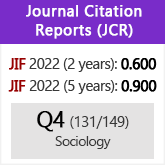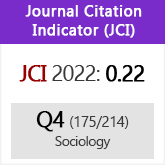Environmental Justice. The State of the Art
DOI:
https://doi.org/10.3989/ris.2009.12.210Keywords:
Environmentalism, Social Justice, Social movementAbstract
Issues of social justice and equity related to the environment have taken place in the environmental justice movement. Previously, the environmental movement had focused, almost exclusively, on issues related to the conservation of the physical environment as well as the reduction of pollutants from the atmosphere, land and water. the environmental justice paradigm, however, has sought, since its origins in the united States three decades ago, to incorporate issues of social justice in the environmental movement, with performances of great national success. the concept of environmental justice is dual, both as a social movement, and as a paradigm with enormous implications in the area of public action. this article will consider, theoretically, the state of the art of environmental justice, with the aim of evaluating the impact this paradigm has on the environmental movement and on political issues.
Downloads
References
Agyeman, J. 2002. “Constructing Environmental (in)Justice: Transatlantic Tales.” Environmental Politics 11: 31-53. http://dx.doi.org/10.1080/714000627
Agyeman, J. 2005. Environmental Justice and Sustainable Communities. Nueva York: New York University Press.
Agyeman, J. 2007. “Environmental justice and sustainability”. Pp. 171-188 en Handbook of Sustainable Development, editado por G. Atkinson, S. Dietz y E. Neumayer. Cheltenham: Edward Elgar.
Agyeman, J. y B. Evans. 2004. “‘Just sustainability’: the emerging discourse of environmental justice in Britain?.” The Geographical Journal 170: 155-164. http://dx.doi.org/10.1111/j.0016-7398.2004.00117.x
Baden, B. M. y D. L. Coursey. 2002. “the locality of waste sites within the city of chicago: a demographic, social, and economic analysis.” Resource and Energy Economics 24: 53-93. http://dx.doi.org/10.1016/S0928-7655(01)00060-4
Been, V. 1994. “Locally undesirable land uses in minority Neighborhoods: Disproportionate Siting or market Dynamics?.” Yale Law Review 103: 1383-1422. http://dx.doi.org/10.2307/797089
Boerner, C. y T. Lambert 1995. “Environmental Injustice.” The Public Interest Winter: 61-82.
Bosque Sendra, J., C. Díaz Castillo y M. A. Díaz Muñoz. 2001-2002. “De la Justicia Espacial a la Justicia ambiental en la política de localización de instalaciones para la gestión de residuos en la comunidad de Madrid.” Boletín de la Real Sociedad Geográfica CXXXVII-CXXXVIII: 89-114.
Bryant, B. 1995. “Issues and Potential Policies and Solutions for Environmental Justice: an overview”. Pp. 8-34 en Environmental Justice. Issues, Policies, and Solutions, editado por B. Bryant. Washington D.C: Island Press.
Bullard, R. D. 1983. “Solid Waste Sites and the Houston Black community.” Sociological Inquiry 53: 273-288. http://dx.doi.org/10.1111/j.1475-682X.1983.tb00037.x PMid:11635985
Bullard, R. D. 1999. “Dismantling Environmental racism in the uSa.” Local Environment 4: 5-19. http://dx.doi.org/10.1080/13549839908725577
Bullard, R. D. 2005. “Environmental Justice in the Twenty-first Century”. Pp. 19-42 en The Quest for Environmental Justice. Human Rights and the Politics of Pollution, editado por R. D. Bullard. San Francisco: Sierra club Books.
Bullard, R. D. y B. H. Wright 1986. “The Politics of Pollution: Implications for the Black Community.” Phylon 47: 71-78. http://dx.doi.org/10.2307/274696
Byrne, J., I. Glover y C. Martínez. 2002. Environmental Justice: Discourses in International Political Economy Energy and Environmental Policy. New Brunswick, N. J.: Transaction Publishers.
Cole, l. W. y S. R. Foster. 2001. From the Ground Up. Environmental Racism and the Rise of the Environmental Justice Movement. Nueva York: New York University Press.
Commoner, B. 1987. “A Reporter at Large (The Environment).” The New Yorker 63: 46-71.
Environmental Justice Network. 2009. Principles of Environmental Justice (en línea) http://www.ejnet.org/ej/principles.html.
Elliott, J. R. y J. Pais. 2006. “Race, class, and Hurricane Katrina: Social differences in human responses to disaster.” Social Science Research 35: 295-321. http://dx.doi.org/10.1016/j.ssresearch.2006.02.003
Faber, D. y D. Mccarthy. 2003. “Neo-liberalism, Globalization, and the Struggle for Ecological Democracy: Linking Sustainability and Environmental Justice”. Pp. 38-63 en Just Sustainabilities: Development in an Unequal World, edited by J. Agyeman, R. D. Bullard y B. Evans. Cambridge: MIt Press.
Fernández, J. 1999. El ecologismo español. madrid: alianza Editorial.
Ferris, D. y D. Hahn-Baker. 1995. “Environmentalists and Environmental Justice Policy”. Pp. 66-75 en Environmental Justice. Issues, Policies, and Solutions, editado por B. Bryant. Washington D.C.: Island Press.
Grass, R. 1995. “Environmental Education and Environmental Justice: a three circles Perspective.” Pathways to outdoor Communication 5: 9-13.
Guha, R. y J. Martínez Alier. 1997. Varieties of Environmentalism: Essays North and South. Londres: Earthscan.
Heiman, M. K. 1996. “Race, waste, and class: news perspectives on environmental justice.” Antipode 28: 111-121. http://dx.doi.org/10.1111/j.1467-8330.1996.tb00517.x
Helfand, G. E. y l. J. Peyton. 1999. “a conceptual model of Environmental Justice.” Social Science Quarterly 80: 68-83.
Hofrichter, R. 1993. “Introduction”. Pp. 1-11 en Toxic Struggles: The Theory and Practice of Environmental Justice, editado por r. Bullard. Philadelphia, Pa: New Society Publishers.
Holifield, R. 2001. “Defining Environmental Justice and Environmental Racism.” Urban Geography 22: 78-90. http://dx.doi.org/10.2747/0272-3638.22.1.78
Ikeme, J. 2003. “Equity, environmental justice and sustainability: incomplete approaches in climate change politics.” Global Environmental Change 13: 195-206. http://dx.doi.org/10.1016/S0959-3780(03)00047-5
Inglehart, r. 1977. The Silent Revolution - Changing Values and Political Styles among Western Mass Publics. Princeton: Princeton University Press.
Jordan, C. y D. Snow 1992. “Diversification, Minorities, and the Mainstream Environmental Movement”. Pp. 71-109 en Voices from the Environmental Movement, editado por c. Snow. Washington D.C: Island Press.
Kameri-Mbote, P. y P. Cullet 1996. “Environmental justice and sustainable development: integrating local communities in environmental management international environmental law research centre (IELRC)”. IELRC Working Paper n.º 1996-1.
López, I. 2010. “Sostenibilidad y cambio social”. Pp 185-207. en catástrofes medioambientales: la reacción social y política, coordinado por J. l. Cases. Valencia: Tirant lo Blanch.
Maslow, a. 1954. Motivation and Personality. Nueva York: Harper.
McDonald, D. a. ed. 2002. Environmental Justice in South Africa. cape town: University of Cape Town.
Melosi, m. v. 2004. Garbage in the Cities. Refuse, Reform, and the Environment (Revised Edition). Pittsburg: university of Pittsburg.
Milbrath, l. W. 1984. Environmentalists: Vanguards for a New Society. albany: SuNY Press.
Mitchell, R. C. 1980. Public Opinion on Environmental Issues: Results of a National Opinion Survey. Washington, D.C: President’s council on Environmental Quality.
Mohai, P. 1990. “Black Environmentalism.” Social Science Quarterly 71: 744-765.
Mohai, P. y B. Bryant. 1992a. “race, Poverty and the Environment.” EPA Journal 18: 6-9.
Mohai, P. y B. Bryant. 1992b. “Environmental racism: reviewing the Evidence”. Pp. 1-9 en Race and the Incidence of Environmental Hazards: A Time for Discourse, editado por P. Mohai y B. Bryant. Boulder, co: Westview Press.
Moreno Jiménez, A. 2007. “¿Está equitativamente repartida la contaminación sonora urbana? una evaluación desde el principio de justicia ambiental en la ciudad de madrid.” Estudios Geográficos LXVIII 263: 595-626.
Moreno Jiménez, a. y R. Cañada Torrecilla. 2007. “Justicia ambiental y contaminación atmosférica por dióxido de azufre en madrid: análisis espacio-temporal y valoración con Sistemas de Información Geográfica.” Boletín de la Asociación Geógrafos Españoles 44: 301-324.
Novotny, P. 2000. Where We Live, Work, and Play: The Environmental Justice Movement and the Struggle for a New Environmentalism. Westport, Connecticut: Praeger.
Pardo, m. 1998. “Sociología y medio ambiente: estado de la cuestión.” Revista Internacional de Sociología: 19-20:329-367.
Patel, Z. 2006. “Of questionable value: The role of practitioners in building sustainable cities.” Geoforum 37: 682-694. http://dx.doi.org/10.1016/j.geoforum.2005.11.008
Pellow, D. N. 2000. “Environmental Inequality Formation: toward a theory of Environmental Injustice.” American Behavioral Scientist 43: 581-601.
Pellow, D. N. 2009. “We Didn’t Get the First 500 Years right, So let’s Work on the Next 500 Years: a call for transformative analysis and action.” Environmental Justice, 2: 3-6. http://dx.doi.org/10.1089/env.2008.0549
Pepper, D. 1984. The Roots of Modern Environmentalism. londres: croom Helm.
Pezzullo, P. c. y r. Sandler. 2007. “Introduction. revisiting the Environmental Justice challenge to Environmentalism”. Pp 1-24. en Environmental Justice and Environmentalism. the Social Justice challenge to the Environmental movement. Cambridge, Massachusetts: MLT Press.
Rhodes, E. l. 2003. Environmental Justice in America. A New Paradigm. Bloomington&Indianapolis: Indiana university Press.
Schlosberg, D. 1999. Environmental Justice and the New Pluralism. The Challenges of Difference for Environmentalism. Oxford: Oxford University Press.
Schlosberg, D. 2007. Defining Environmental Justice. Theories, Movements, and Nature. Oxford: Oxford University Press. http://dx.doi.org/10.1093/acprof:oso/9780199286294.001.0001
Sze, J. 2006. “Toxic Soup Redux: Why Environmental Racism and Environmental Justice Matter after Katrina”, en Understanding Katrina (en línea). http://understandingkatrina.ssrc.org/Sze/. Fecha de consulta 28/09/2008.
Taylor, D. 2000. “The rise of the Environmental Justice Paradigm: Injustice Framing and the Social construction of Environmental discourses.” American Behovioral Scientist 43: 508-580.
United Church of Christ Commission for Racial Justice. 1987. Toxic Wastes and Race in the United States. New York: United Church of Christ Commission For Racial Justice.
United States General Accounting Office. 1983. Siting of Hazardous Waste Land. lls and their Correlation with Racial and Economic Status of Surrounding Communities. Washington, D.C: GPO.
Warner, K. 2002. “Linking local Sustainability Initiatives with Environmental Justice.” Local Environment 7: 35-47. http://dx.doi.org/10.1080/13549830220115402
Downloads
Published
How to Cite
Issue
Section
License
Copyright (c) 2011 Consejo Superior de Investigaciones Científicas (CSIC)

This work is licensed under a Creative Commons Attribution 4.0 International License.
© CSIC. Manuscripts published in both the printed and online versions of this Journal are the property of Consejo Superior de Investigaciones Científicas, and quoting this source is a requirement for any partial or full reproduction.All contents of this electronic edition, except where otherwise noted, are distributed under a “Creative Commons Attribution 4.0 International” (CC BY 4.0) License. You may read here the basic information and the legal text of the license. The indication of the CC BY 4.0 License must be expressly stated in this way when necessary.
Self-archiving in repositories, personal webpages or similar, of any version other than the published by the Editor, is not allowed.

















